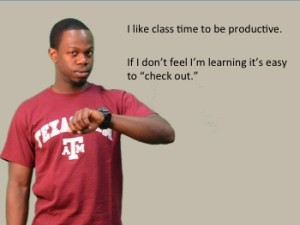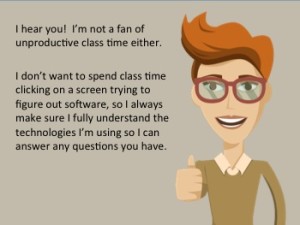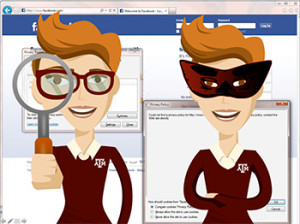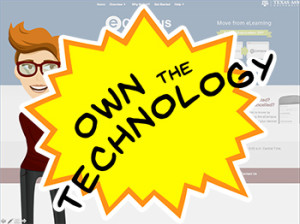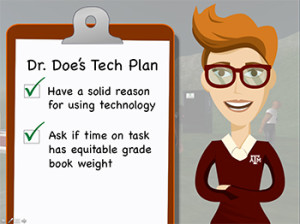Read how a clip art professor taught this designer a thing or two about best practices.
Recently my department agreed to co-present multiple sessions of a face-to-face workshop in conjunction with two other departments on campus. Due to departmental calendaring issues, I was ‘volunteered’ to present on best practices for integrating technology into an online classroom.
I was a little apprehensive. For starters, that phrase ‘best practices’ is an over-used phrase that fails to hold anyone’s attention. Additionally, I’m always out of my comfort zone presenting on the softer side of technology, even though I’m as well-qualified for the task as any of my co-workers. My true love is the technology itself; with all the cool features, workarounds, and unexpected uses; all the sneaky ways to get data to bow to my every whim. I can talk tech all day. On the other hand, when I make pedagogy-centered presentations I’m always a little afraid someone will “see through” my act, and point out I’m not a true expert. After all, I didn’t love pedagogy enough to go for that PhD.
The first workshop fell in the middle of a crowded week, so my intern Courtney and I threw together the presentation in about two hours. It wasn’t my best work, but I liked the end result, especially Courtney’s contributions. I felt our rushed ‘best practices’ could be the start of something better — a Student Bill of Rights for Technology Integration. Surely a student-centered approach would be more engaging than overused ‘best practices!’
In the following week, I played with the concept. Last year one of our department’s past student assistants, John (a wonderful ham) had modeled for us so we could make cutout people that are representative of our student body. I used those images in conjunction with a great clip art package from Tracey Meagher. The Hipster Chick Female, also known as Ms. Mustachina, came with 8 different poses and a foam finger! What could be better?
The slides were very text-heavy initially, as I thought maybe the department could use the presentation as an online module somewhere. The story took place during a meeting between John (a senior jaded by technology misused in class) and Ms. Mustachina. John wanted to ask Ms. Mustachina questions about her class before enrolling. The whole presentation used an ask-and-answer format, with John asking a question, and Ms. Mustachina relating how she planned to accommodate John’s needs.
I felt like this needed work, but was on the right track. A few days later my workshop group met, and reviewed the revised presentation. Everyone agreed the new presentation was more engaging and we should use it for the next workshop, but it needed significant revision so it wasn’t as text-heavy. (Insert huge sigh — time for another session in front of the computer.)
I had fully intended to replace the clip art professor, but my co-workers objected. The felt very strongly that this wonderfully androgynous figure was more generic than photo cutouts could ever be. Everyone thought the faculty in our audience would be able to identify more with the cartoon than with a model who could be identified with potentially prejudicial racial, gender, or generational descriptors.
I next argued for replacing the student with a cartoon student, but my co-workers liked John. A cartoon probably couldn’t convey as much expression, and John’s outfit branded him as a typical student at our institution. He’s one of ours, in a way a cartoon could never quantify.
Personally, I felt there was a huge disconnect between the cartoon character and a realistic student, but since the rest of the office argued so strongly I realized the disconnect was probably personal. My co-workers were pushing for content, while I was quibbling over style, so I let my co-workers carry the day.
We renamed the professor to emphasize the androgyny aspect. His/her first name, naturally, is Pat. To further emphasize the character’s generic nature we chose the imaginative last name of Doe. Dr. Doe also received a slight wardrobe makeover. We garbed him/her school colors and added our logo to his/her sweater.
I also felt that something else was wrong with the presentation. My Student Bill of Rights didn’t fit in as well as I’d hoped. It was the last slide in the presentation, and it didn’t have a good reason to be there at all. I was telling a story, but I couldn’t figure out a clean way to introduce the SBoR into the story. How would John know about the bill? And if John knew about it, that implied it was a guideline handed down from administration. (Maybe John read an article in the school newspaper?) If the bill was that widespread and that important, Dr. Doe would already know about it. (After all, Dr. Doe is pretty fabulous.)
I ignored the problem for a while, and continued working on the presentation. Dr. Doe acquired accessories to help tell the story, mostly using clip art from openclipart.org. In the slide below, for example, s/he’s holding a magnifying glass to better read website privacy policies, and also wearing a mask to encourage students to conceal their personal information from 3rd-party sites. Almost all of the text disappeared. I planned on using the different Dr. Doe images as speaking prompts.
While I liked the freedom of text-less slides, I realized it made sense to offer some summary text for our audience highlighting the takeaways. Initially, the project made a wrong turn by using ‘action bubbles’ to convey the takeaways, but I decided the action bubbles had no relation to the story I was telling. (Dr. Doe wasn’t a superhero; just a super professor.) The ‘action bubbles’ also felt needlessly adversarial — “BAM! Take that, John! I know what to do if a web service shuts down!” cackled Dr. Doe.
After some reflection, I chose a more sedate clipboard to hold the summary text. I put a title on the clipboard’s paper, “Dr. Doe’s Tech Plan,” and added specific actions Dr. Doe performed to be ready to use technology in the classroom. I changed the story so John was asking about technology integration during the first class of the semester, and featured the clipboard at the end of each question/answer cycle.
That’s when it hit me — John was not the star of the presentation. Dr. Doe was the star! I didn’t need to highlight a student-centered bill; instead, I needed to focus on Dr. Doe’s Technology Integration Plan. My presentation didn’t need to be student-centered — it needed to be faculty-centered! By ditching ‘best practices’ for technology integration I’d come full circle, and inadvertently embraced a ‘best practice’ for presentations. The audience (represented by Dr. Doe) stole the spotlight and became the star.


